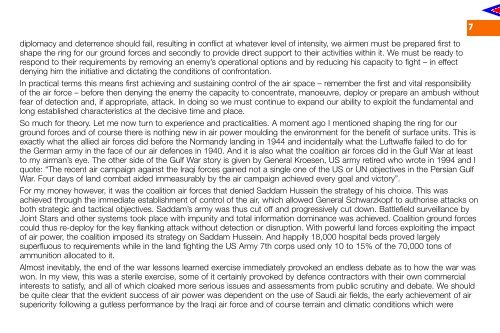THE RAF AIR POWER REVIEW - Royal Air Force Centre for Air ...
THE RAF AIR POWER REVIEW - Royal Air Force Centre for Air ...
THE RAF AIR POWER REVIEW - Royal Air Force Centre for Air ...
Create successful ePaper yourself
Turn your PDF publications into a flip-book with our unique Google optimized e-Paper software.
diplomacy and deterrence should fail, resulting in conflict at whatever level of intensity, we airmen must be prepared first to<br />
shape the ring <strong>for</strong> our ground <strong>for</strong>ces and secondly to provide direct support to their activities within it. We must be ready to<br />
respond to their requirements by removing an enemy’s operational options and by reducing his capacity to fight – in effect<br />
denying him the initiative and dictating the conditions of confrontation.<br />
In practical terms this means first achieving and sustaining control of the air space – remember the first and vital responsibility<br />
of the air <strong>for</strong>ce – be<strong>for</strong>e then denying the enemy the capacity to concentrate, manoeuvre, deploy or prepare an ambush without<br />
fear of detection and, if appropriate, attack. In doing so we must continue to expand our ability to exploit the fundamental and<br />
long established characteristics at the decisive time and place.<br />
So much <strong>for</strong> theory. Let me now turn to experience and practicalities. A moment ago I mentioned shaping the ring <strong>for</strong> our<br />
ground <strong>for</strong>ces and of course there is nothing new in air power moulding the environment <strong>for</strong> the benefit of surface units. This is<br />
exactly what the allied air <strong>for</strong>ces did be<strong>for</strong>e the Normandy landing in 1944 and incidentally what the Luftwaffe failed to do <strong>for</strong><br />
the German army in the face of our air defences in 1940. And it is also what the coalition air <strong>for</strong>ces did in the Gulf War at least<br />
to my airman’s eye. The other side of the Gulf War story is given by General Kroesen, US army retired who wrote in 1994 and I<br />
quote: “The recent air campaign against the Iraqi <strong>for</strong>ces gained not a single one of the US or UN objectives in the Persian Gulf<br />
War. Four days of land combat aided immeasurably by the air campaign achieved every goal and victory”.<br />
For my money however, it was the coalition air <strong>for</strong>ces that denied Saddam Hussein the strategy of his choice. This was<br />
achieved through the immediate establishment of control of the air, which allowed General Schwarzkopf to authorise attacks on<br />
both strategic and tactical objectives. Saddam’s army was thus cut off and progressively cut down. Battlefield surveillance by<br />
Joint Stars and other systems took place with impunity and total in<strong>for</strong>mation dominance was achieved. Coalition ground <strong>for</strong>ces<br />
could thus re-deploy <strong>for</strong> the key flanking attack without detection or disruption. With powerful land <strong>for</strong>ces exploiting the impact<br />
of air power, the coalition imposed its strategy on Saddam Hussein. And happily 18,000 hospital beds proved largely<br />
superfluous to requirements while in the land fighting the US Army 7th corps used only 10 to 15% of the 70,000 tons of<br />
ammunition allocated to it.<br />
Almost inevitably, the end of the war lessons learned exercise immediately provoked an endless debate as to how the war was<br />
won. In my view, this was a sterile exercise, some of it certainly provoked by defence contractors with their own commercial<br />
interests to satisfy, and all of which cloaked more serious issues and assessments from public scrutiny and debate. We should<br />
be quite clear that the evident success of air power was dependent on the use of Saudi air fields, the early achievement of air<br />
superiority following a gutless per<strong>for</strong>mance by the Iraqi air <strong>for</strong>ce and of course terrain and climatic conditions which were<br />
7

















